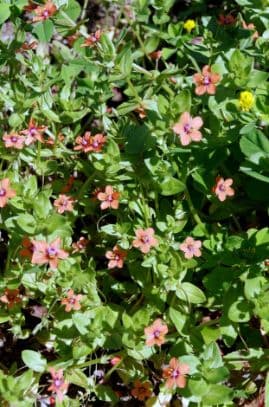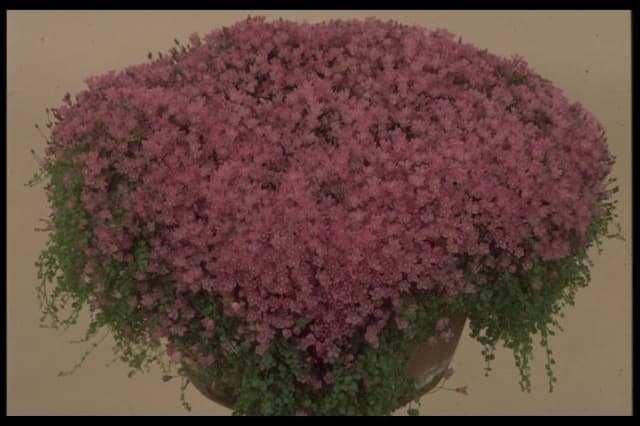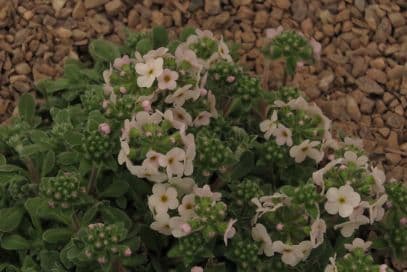Dionysia Dionysia 'Monika'

ABOUT
Dionysia 'Monika', commonly referred to as simply Dionysia, is a captivating plant known for its dense cushion or mat-forming growth habit. This perennial showcases a wealth of small, rounded leaves that are tightly packed together, creating a lush, moss-like appearance. The foliage can be quite variable in color, ranging from bright green to grey-green hues, with some varieties developing red or purple tones in cooler conditions, giving the plant a rich tapestry of color throughout the year. During its blooming period, Dionysia 'Monika' becomes even more striking. The plant produces an abundance of tiny, yet vibrant flowers that can appear in shades of yellow, pink, purple, or white. These flowers are often funnel-shaped and may have delicate, darker markings that add to their intricate beauty. The blooms are held closely to the cushion of leaves, nestled among the foliage, creating a delightful contrast and a spectacular display that captures the eye. The overall texture of the plant is fine yet dense, with the leaves and flowers working together to form a compact, mound-like structure. This feature, combined with the showy flowers and the intricate details of the leaves, makes Dionysia 'Monika' a desirable plant for rock gardens, alpine displays, or as a special feature in small garden spaces where its detailed beauty can be appreciated up close. Its evergreen nature ensures that it remains attractive throughout the year, not only when it is in bloom, offering consistent visual interest.
About this plant
 Names
NamesFamily
Primulaceae
Synonyms
Manita, Finger Primrose
Common names
Dionysia 'Monika'
 Toxicity
ToxicityTo humans
The Dionysia 'Monika' generally known as "Dionysia", does not have well-documented toxicity to humans in the available literature. As with any plant, it is advisable to handle it with care, and to avoid ingestion, as the specific effects on humans may not be well-understood due to a lack of reported cases or thorough research. If any part of the Dionysia is ingested and symptoms of poisoning occur, it is important to seek medical advice.
To pets
Dionysia 'Monika', also commonly referred to as "Dionysia", is not widely known for its toxicity to pets. However, the absence of information on its toxicity does not necessarily ensure safety, as comprehensive studies may not have been conducted on this particular variety. It's prudent to discourage pets from ingesting any part of the plant, and if they do, and display signs of distress or poisoning, it is crucial to consult a veterinarian promptly.
 Characteristics
CharacteristicsLife cycle
Perennials
Foliage type
Evergreen
Color of leaves
Green
Flower color
Yellow
Height
6 inches (15 cm)
Spread
6 inches (15 cm)
Plant type
Herb
Hardiness zones
7
Native area
Iran
Benefits
 General Benefits
General Benefits- Aesthetic Appeal: Dionysia 'Monika', commonly known as Dione, offers gardeners vibrant and colorful flowers that enhance the visual beauty of gardens and indoor spaces.
- Compact Growth: Its small and compact size makes it suitable for rock gardens, alpine displays, and containers, allowing for versatile garden design options.
- Bee-Friendly: The blooms of Dione provide a source of nectar for bees and other pollinators, supporting biodiversity in the garden.
- Minimal Maintenance: Adaptable to various conditions, Dionysia 'Monika' generally requires minimal maintenance, making it ideal for both experienced and novice gardeners.
- Cold Tolerance: Dionysia 'Monika' is known to be relatively hardy in cool conditions, which can be beneficial in gardens located in colder climates.
- Long Blooming Period: It can have an extended flowering season from late winter into spring, bringing color to the garden during a time when few other plants are in bloom.
- Adaptability: While preferring well-drained soil, the Dione plant can adapt to different soil types if the necessary drainage is provided, showing some flexibility in planting conditions.
- Evergreen Foliage: The plant maintains its foliage throughout the year, ensuring that the garden remains green even outside the flowering period.
 Medical Properties
Medical PropertiesThis plant is not used for medical purposes.
 Air-purifying Qualities
Air-purifying QualitiesThis plant is not specifically known for air purifying qualities.
 Other Uses
Other Uses- Dionysia 'Monika', commonly known as simply Dionysia, can be used in miniature rock gardens due to its compact growth habit, adding unique texture and color among the rocks and stones.
- The small, cushion-like form of Dionysia can be integrated into fairy gardens to provide a realistic and enchanted landscape appearance, resembling mossy hills.
- Intricate terrarium ecosystems can utilize Dionysia as a specimen plant, offering a variation in foliage within the confined glass space.
- Dionysia can be cultivated in alpine troughs, which are container gardens designed to simulate alpine conditions, where it adds authenticity with its alpine origin.
- Artists and photographers may use Dionysia as a subject in botanic art or macro photography due to its intricate flowers and foliage.
- Education enthusiasts can use Dionysia to teach principles of alpine plant care and propagation to students and hobbyists interested in specialized gardening.
- Dionysia's attractive flowers can be used in the creation of pressed flower art, where their colorful blooms can be preserved and displayed.
- Due to its small size, Dionysia can play a role in bonsai or miniature gardening communities as an example of manipulating plant shapes in scale with miniature scenes.
- With its distinctive appearance, Dionysia can serve as a living ornament during blooming season when potted attractively and displayed on patios or balconies.
- Culinary enthusiasts interested in edible flowers can experiment with Dionysia's blooms, though their taste and edibility should be researched and confirmed prior to ingestion.
Interesting Facts
 Feng Shui
Feng ShuiThe Dionysia is not used in Feng Shui practice.
 Zodiac Sign Compitability
Zodiac Sign CompitabilityThe Dionysia is not used in astrology practice.
 Plant Symbolism
Plant Symbolism- Endurance and Survival: Dionysias are known for their ability to thrive in harsh, rocky environments, symbolizing the traits of resilience and the capacity to endure difficult conditions.
- Preciousness and Rarity: Because Dionysia 'Monika' is a rare and often sought after plant among enthusiasts, it represents the value and rarity that can be found in the small and unique aspects of life.
- Determination: The growth habit of clinging to cliffs and the plant's determination to bloom in less than ideal circumstances symbolize persistence and the drive to succeed against the odds.
- Adaptability: Dionysias, adapted to their specific mountainous habitats, symbolize the ability to adjust to changing environments and make the most out of current conditions.
 Water
WaterFor the Dionysia 'Monika', also known as cushion plant, water thoroughly but infrequently, allowing the soil to dry slightly between waterings. Typically, watering once a week with about 16 ounces of water is sufficient. During the growing season in spring and summer, keep the soil consistently moist but not soggy. In winter, reduce watering to every other week to prevent root rot. Always use lukewarm water and avoid getting water on the leaves to minimize the risk of fungal diseases.
 Light
LightCushion plants like Dionysia 'Monika' thrive best in bright, indirect light. A north-facing windowsill that offers bright light without direct sun is ideal for these plants. Protect them from the intense midday sun, which can scorch their delicate leaves.
 Temperature
TemperatureThe cushion plant prefers cool to moderate temperatures, ideally between 50°F and 68°F. Dionysia 'Monika' can tolerate a minimum temperature of 40°F, but growth will be inhibited below this. Avoid exposure to temperatures above 80°F to prevent heat stress.
 Pruning
PruningPrune cushion plants like Dionysia 'Monika' to remove any dead or yellowing leaves and to shape the plant. This promotes healthy growth and improves airflow, which can prevent fungal diseases. Prune lightly in spring or after flowering, but avoid heavy pruning, as this can stress the plant.
 Cleaning
CleaningAs needed
 Soil
SoilThe best soil mix for Dionysia, also known as cushion bush, consists of well-draining gritty mix, such as equal parts of loam, sand, and perlite or pumice. The ideal pH for cushion bush should be slightly acidic to neutral, ranging from 6.0 to 7.0.
 Repotting
RepottingDionysia 'Monika', or cushion bush, should be repotted every 1-2 years to refresh the soil and prevent it from becoming compacted. Spring is the best time to repot this plant.
 Humidity & Misting
Humidity & MistingCushion bush thrives in moderate to high humidity levels, typically around 40-50%. It is important to maintain steady humidity but avoid overly wet conditions that can lead to rot.
 Suitable locations
Suitable locationsIndoor
Place cushion bush in bright, indirect light and ensure high humidity.
Outdoor
Grow cushion bush in a sunny spot with protection from harsh midday sun.
Hardiness zone
5-7 USDA
 Life cycle
Life cycleDionysia 'Monika', commonly known as a type of cushion primrose, typically begins its life cycle as a seed, which germinates when conditions of moisture, temperature, and light are favorable. Upon germination, a small seedling emerges and establishes a root system while developing its first set of true leaves. As it matures, Dionysia 'Monika' grows into a compact, cushion-like perennial with a tight rosette of leaves, during which it focuses on vegetative growth to build up reserves. Once mature, usually after a year or more, the plant produces vibrant flower clusters in spring, signaling the onset of its reproductive phase. Following pollination, often by insects, seeds are produced and dispersed, completing its reproductive cycle. The plant then enters a period of dormancy, particularly in colder climates, conserving energy to survive the winter and to restart the cycle in the following growing season.
 Propogation
PropogationPropogation time
Spring-Early Summer
For the Dionysia 'Monika', commonly known as a type of cushion or alpine plant, the most popular method of propagation is by seed. Sowing can be done in late winter to early spring. Fresh seeds are scattered on the surface of a well-draining seed starting mix, typically in a shallow tray or pot. The seeds require light for germination, so they should not be covered with soil. Instead, the tray is kept moist and placed in a bright area but out of direct sunlight. Maintaining a consistent temperature around 70 degrees Fahrenheit (about 21 degrees Celsius) will encourage germination. After seeds germinate, which can take several weeks to a few months, seedlings are carefully transplanted into individual pots once they are large enough to handle.









